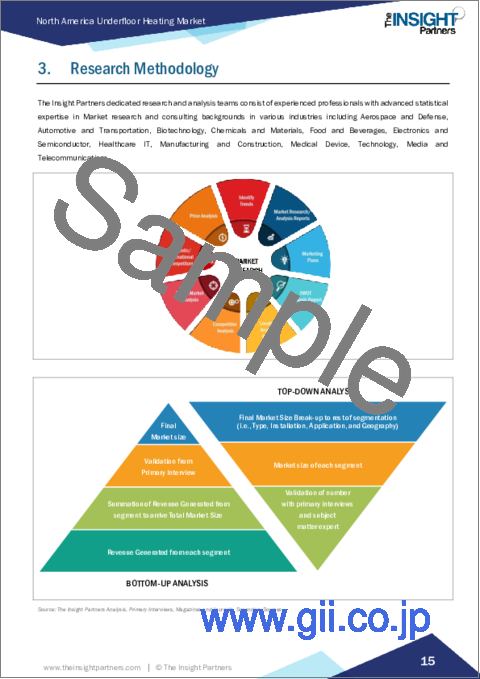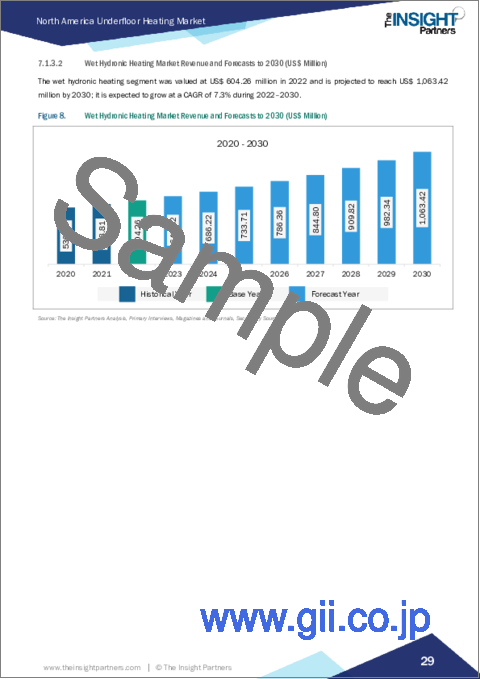|
|
市場調査レポート
商品コード
1562432
北米の床暖房市場の2030年予測- 地域別分析- タイプ別、設置別、用途別North America Underfloor Heating Market Forecast to 2030 - Regional Analysis - by Type (Hydronic System Components and Electric System Components), Installation (Retrofit and New), and Application (Residential and Commercial) |
||||||
|
|||||||
| 北米の床暖房市場の2030年予測- 地域別分析- タイプ別、設置別、用途別 |
|
出版日: 2024年07月04日
発行: The Insight Partners
ページ情報: 英文 108 Pages
納期: 即納可能
|
全表示
- 概要
- 図表
- 目次
北米の床暖房市場は2022年に11億8,794万米ドルと評価され、2030年には21億4,851万米ドルに達すると予測され、2022~2030年のCAGRは7.7%と推定されます。
建設産業への投資増加が北米の床暖房市場を活性化。
床暖房は、米国、中国、インドなどの寒冷地域でますます普及し、採用されるようになってきています。床暖房は温度を一定に保ち、空気の質を向上させるなど幅広い用途があるため、世界の多くの国で半砂漠や砂漠といった気候条件が存在し、砂漠では夜間に気温がマイナス以下になるため、床暖房市場の成長にプラスの影響を与えると予想されます。建設産業への投資の増加と生活水準を向上させるための個人の消費力の増加は、床暖房市場に有利に働くと予測されています。建設産業は経済成長と社会進歩の基盤です。地域社会の物理的景観を形成し、雇用創出を促進し、イノベーションを推進する上で極めて重要な役割を担っています。急速に発展する今日の世界では、インフラ需要が投資のペース、経済的可能性、生活の質を上回っています。そのため、世界中の政府やその他の団体が、商業・住宅両方の建設業界に投資しています。例えば、2023年10月現在、米国の一戸建て住宅建設は、中古住宅が不足する中、新築需要に牽引され、2023年9月に力強い復活を遂げました。しかし、約23年ぶりの高水準に達した住宅ローン金利の急上昇は、この勢いを鈍らせる可能性があります。米国商務省によると、住宅建設の大半を占める9月の一戸建て住宅着工戸数は、季節調整済み年率で3.2%増の96万3,000戸でした。この数字は2023年8月に発表された93万3,000戸から修正されました。2023年9月の住宅着工件数は7.0%増の135万8,000戸となり、エコノミストの予想を若干下回った。米国政府は、世界市場における米国の建築資材、化学製品、金属の競合を強化することで、建設セクターを支援しています。建設業界の成長は床暖房市場を活性化させると予想されます。
北米の床暖房市場概要
北米の寒冷地における床暖房需要の増加は、米国、カナダ、メキシコなどの先進国における建築・建設産業の急成長の結果として予測されます。また、同地域の様々な参入企業が、暖かい床を提供することで、キッチンやバスルームの快適性や利便性に応えて床暖房を提供しています。2020年2月、ニューファンドランドを拠点とするスマートホーム技術企業Mysa Smart Thermostatsは、電気式床暖房の発売を発表しました。発売された製品は、北米の家庭がエネルギーを効率的に使用できるようにすることで、電気代をよりコントロールできるようにします。
北米の気候は寒さが厳しいことで知られ、アラスカ(米国)、カナダ北部、グリーンランドなど極地の地域はさらに寒いです。そのため、この地域に住む人々は冬に暖かさを必要としています。米国25州の州知事は、2030年までにヒートポンプ導入台数2,000万台を達成するために連合を結成しました。これを受けて、米国では2020年に480万台のヒートポンプが設置されました。ヒートポンプはエネルギー効率が高く、化石燃料で動く暖炉やエアコンの代わりとなります。ヒートポンプは、熱を発生させるのとは対照的に、電気を使用して熱を移動させ、外が寒いときには建物を暖め、外が暑いときには建物を冷やすことができます。ガスボイラーに比べ、ヒートポンプは温室効果ガスの排出を20%削減し、エネルギー効率も高いです。各州の知事は、温室効果ガス排出量への注目とともに、住民のサステイナブル暖房に注目しています。ボイラーやヒートポンプに接続された床暖房は、便利なオプションです。このように、政府の取り組みと北米全域の寒冷な気候が床暖房市場の成長を促進すると考えられます。
北米の床暖房市場の収益と2030年までの予測(金額)
北米の床暖房市場セグメンテーション
北米の床暖房市場は、タイプ、設置、用途、国によって区分されます。タイプ別では、北米の床暖房市場はハイドロニックシステムコンポーネントと電気システムコンポーネントに二分されます。2022年には、ハイドロニックシステムコンポーネントサービスがより大きな市場シェアを占める。ハイドロニックシステムコンポーネントは、ウェットハイドロニックヒーティングとドライハイドロニックヒーティングに細分化されます。さらに、電気システム部品はヒーティングマットとヒーティングケーブルに二分されます。
設置別では、北米の床暖房市場は後付けと新設に二分されます。2022年の市場シェアは後付けが大きいです。
用途別では、北米の床暖房市場は住宅用と商業用に二分されます。2022年の市場シェアは住宅用が大きいです。
国別では、北米の床暖房市場は米国、カナダ、メキシコに区分されます。2022年の北米の床暖房市場シェアは米国が独占しています。
Danfoss AS、Emerson Electric Co、nVent Electric Plc、Watts Water Technologies Inc、Robert Bosch GmbH、Resideo Technologies Inc、Uponor Corp、REHAU Ltd、Schneider Electric SEは北米の床暖房市場で事業を展開する主要企業です。
目次
第1章 イントロダクション
第2章 エグゼクティブサマリー
- 主要洞察
- 市場の魅力
第3章 調査手法
- 調査範囲
- 2次調査
- 1次調査
第4章 北米の床暖房市場情勢
- イントロダクション
- エコシステム分析
第5章 北米の床暖房市場:主要産業力学
- 促進要因
- 建設産業への投資の増加
- スマートホーム技術の採用拡大
- 抑制要因
- 床暖房システムの高い設置コスト
- 床暖房システムの設置の複雑さ
- ビジネス機会
- IoT対応床暖房システム
- エネルギー効率の高い床暖房システムの利用拡大
- 動向
- 床暖房へのサステイナブル技術の利用
- 促進要因と抑制要因の影響
第6章 床暖房市場:北米分析
- 床暖房市場の収益(2020~2030年)
- 床暖房市場の予測と分析
第7章 北米の床暖房市場分析:タイプ
- ハイドロニックシステムコンポーネント
- ハイドロニックシステムコンポーネント市場の収益と2030年までの予測
- 温水式熱暖房
- 湿式水熱暖房市場の収益と2030年までの予測
- 乾式水熱暖房
- 乾式水熱暖房市場の収益と2030年までの予測
- 電気システムコンポーネント
- 電気システム市場の収益と2030年までの予測
- 暖房マット
- 暖房マット市場の収益と2030年までの予測
- 暖房ケーブル
- 暖房ケーブル市場の収益と2030年までの予測
第8章 北米の床暖房市場分析:設置
- 改修設置
- 改修設置市場の収益と2030年までの予測
- 新規
- 新規市場の収益と2030年までの予測
第9章 北米の床暖房市場分析-用途
- 住宅用
- 住宅用市場の収益と2030年までの予測
- 商業用
- 商業用市場の収益と2030年までの予測
第10章 北米の床暖房市場:国別分析
- 北米市場概要
- 米国
- カナダ
- メキシコ
第11章 競合情勢
- 主要参入企業によるヒートマップ分析
- 企業のポジショニングと集中度
第12章 業界情勢
- イントロダクション
- 市場の取り組み
第13章 企業プロファイル
- Danfoss A/S
- Emerson Electric Co
- nVent Electric plc
- Watts Water Technologies, Inc.
- Robert Bosch GmbH
- Resideo Technologies Inc.
- Uponor Corp
- REHAU Ltd
- Schneider Electric SE
第14章 付録
List Of Tables
- Table 1. Underfloor Heating Market Segmentation
- Table 2. Underfloor Heating Market Revenue and Forecasts to 2030 (US$ Million)
- Table 3. Underfloor Heating Market Revenue and Forecasts to 2030 (US$ Million) - Type
- Table 4. Underfloor Heating Market Revenue and Forecasts to 2030 (US$ Million) - Installation
- Table 5. Underfloor Heating Market Revenue and Forecasts to 2030 (US$ Million) - Application
- Table 6. North America Underfloor Heating Market, by Country - Revenue and Forecast to 2030 (USD Million)
- Table 7. US Underfloor Heating Market Revenue and Forecasts to 2030 (US$ Mn) - By Type
- Table 8. US Underfloor Heating Market Revenue and Forecasts to 2030 (US$ Mn) - By Hydronic System Components
- Table 9. US Underfloor Heating Market Revenue and Forecasts to 2030 (US$ Mn) - By Electric System Components
- Table 10. US Underfloor Heating Market Revenue and Forecasts to 2030 (US$ Mn) - By Installation
- Table 11. US Underfloor Heating Market Revenue and Forecasts to 2030 (US$ Mn) - By Application
- Table 12. Canada Underfloor Heating Market Revenue and Forecasts to 2030 (US$ Mn) - By Type
- Table 13. Canada Underfloor Heating Market Revenue and Forecasts to 2030 (US$ Mn) - By Hydronic System Components
- Table 14. Canada Underfloor Heating Market Revenue and Forecasts to 2030 (US$ Mn) - By Electric System Components
- Table 15. Canada Underfloor Heating Market Revenue and Forecasts to 2030 (US$ Mn) - By Installation
- Table 16. Canada Underfloor Heating Market Revenue and Forecasts to 2030 (US$ Mn) - By Application
- Table 17. Mexico Underfloor Heating Market Revenue and Forecasts to 2030 (US$ Mn) - By Type
- Table 18. Mexico Underfloor Heating Market Revenue and Forecasts to 2030 (US$ Mn) - By Hydronic System Components
- Table 19. Mexico Underfloor Heating Market Revenue and Forecasts to 2030 (US$ Mn) - By Electric System Components
- Table 20. Mexico Underfloor Heating Market Revenue and Forecasts to 2030 (US$ Mn) - By Installation
- Table 21. Mexico Underfloor Heating Market Revenue and Forecasts to 2030 (US$ Mn) - By Application
- Table 22. Heat Map Analysis
- Table 23. List of Abbreviation
List Of Figures
- Figure 1. Underfloor Heating Market Segmentation, By Country
- Figure 2. Ecosystem: Underfloor Heating Market
- Figure 3. Underfloor Heating Market - Key Industry Dynamics
- Figure 4. Impact Analysis of Drivers and Restraints
- Figure 5. Underfloor Heating Market Revenue (US$ Million), 2020 & 2030
- Figure 6. Underfloor Heating Market Share (%) - Type, 2022 and 2030
- Figure 7. Hydronic System Components Market Revenue and Forecasts to 2030 (US$ Million)
- Figure 8. Wet Hydronic Heating Market Revenue and Forecasts to 2030 (US$ Million)
- Figure 9. Dry Hydronic Heating Market Revenue and Forecasts to 2030 (US$ Million)
- Figure 10. Electric System Components Market Revenue and Forecasts to 2030 (US$ Million)
- Figure 11. Heating Mats Market Revenue and Forecasts to 2030 (US$ Million)
- Figure 12. Heating Cables Market Revenue and Forecasts to 2030 (US$ Million)
- Figure 13. Underfloor Heating Market Share (%) - Installation, 2022 and 2030
- Figure 14. Retrofit Market Revenue and Forecasts to 2030 (US$ Million)
- Figure 15. New Market Revenue and Forecasts to 2030 (US$ Million)
- Figure 16. Underfloor Heating Market Share (%) - Application, 2022 and 2030
- Figure 17. Residential Market Revenue and Forecasts to 2030 (US$ Million)
- Figure 18. Commercial Market Revenue and Forecasts to 2030 (US$ Million)
- Figure 19. North America Underfloor Heating Market, by Key Countries - Revenue (2022) (US$ Million)
- Figure 20. Underfloor Heating Market Breakdown by Key Countries, 2022 and 2030 (%)
- Figure 21. US Underfloor Heating Market Revenue and Forecasts to 2030 (US$ Mn)
- Figure 22. Canada Underfloor Heating Market Revenue and Forecasts to 2030 (US$ Mn)
- Figure 23. Mexico Underfloor Heating Market Revenue and Forecasts to 2030 (US$ Mn)
- Figure 24. Company Positioning & Concentration
The North America underfloor heating market was valued at US$ 1,187.94 million in 2022 and is expected to reach US$ 2,148.51 million by 2030; it is estimated to register a CAGR of 7.7% from 2022 to 2030.
Increasing Investment in Construction Industry Fuels North America Underfloor Heating Market.
Underfloor heating is becoming more and more popular and being adopted in the colder regions of countries such as the US, China, and India, where fast development in the building sector also fueling the underfloor heating market expansion. Due to the wide range of uses for underfloor heating such as maintaining of consistent temperature and improve air quality, the existence of semi-desert and desert climatic conditions in many countries worldwide is expected to impact the underfloor heating market growth positively, as during the night in deserts the temperature fall below minus. The growing investment in the construction industry and the increasing spending power of individuals to improve living standards are projected to favor the underfloor heating market. The construction industry stands as a foundation of economic growth and societal progress. It plays a pivotal role in shaping the physical landscape of communities, fostering job creation, and propelling innovation. In today's rapidly evolving world, infrastructure demands are outpacing the pace of investment, economic potential, and quality of life. Thus, several governments and other entities across the world are investing in the construction industry-both in the commercial and residential sectors. For instance, as of October 2023, Single-family homebuilding in the US had a robust resurgence in September 2023, driven by demand for new construction amid a lack of previously owned homes. However, the surge in mortgage rates, reaching the highest level in almost 23 years, could potentially slow down this momentum. According to the US Commerce Department, single-family housing starts, which make up the majority of homebuilding, rose by 3.2% to a seasonally adjusted annual rate of 963,000 units in September. This figure was revised from the previously reported 933,000 units in August 2023. Overall, housing starts increased by 7.0% to 1.358 million units in September 2023, slightly below economists' expectations. The US government provides support to the construction sector by enhancing the competitiveness of American building goods, chemicals, and metals in global markets. The growth in construction industry is expected to fuel the underfloor heating market.
North America Underfloor Heating Market Overview
Increased demand for underfloor heating in North America's cold zones is predicted as a result of the building & construction industry's rapid rise in developed nations such as the US, Canada, and Mexico. Moreover, various players across the region are providing underfloor heating in response to the comfort and convenience in the kitchens and bathrooms by providing warm floor. In February 2020, Mysa Smart Thermostats, a Newfoundland-based smart-home tech company, announced the launch of Electric In-underfloor heating. The launched product provides households across North America with greater control over their electricity bills by helping them use energy more efficiently.
The North American climate is known to be intensely cold, and the regions extreme polar location such as Alaska (USA), Northern Canada and Greenland, is colder. Thus, the people located in the region need warmth in winter. The governors of 25 states of US formed a coalition in order to reach 20 million deployed heat pumps by 2030. In response, 4.8 million heat pumps were installed in the US in 2020. Heat pumps are energy efficient and act as replacements for fossil fuel-powered furnaces and air conditioners. They use electricity to transfer heat, as opposed to generating heat, and they can either heat a building when it is cold outside or cool a building when it is hot outside. Compared to a gas boiler, heat pumps reduce greenhouse gas emissions by 20% and are also energy efficient. The governors of the states are focusing on the sustainable heating of the residents along with the focus on greenhouse gas emissions. The underfloor heating connected to a boiler or heat pump is a convenient option. Thus, the government initiatives and cold climate across North America will propel the growth of the underfloor heating market.
North America Underfloor Heating Market Revenue and Forecast to 2030 (US$ Million)
North America Underfloor Heating Market Segmentation
The North America underfloor heating market is segmented based on type, installations, application, and country. Based on type, the North America underfloor heating market is bifurcated into hydronic system components and electric system components. The hydronic system components services held a larger market share in 2022. The hydronic system components is sub segmented into wet hydronic heating and dry hydronic heating. Furthermore, electric system components is bifurcated into heating mats and heating cables.
Based on installation, the North America underfloor heating market is bifurcated into retrofit and new. The retrofit held a larger market share in 2022.
Based on application, the North America underfloor heating market is bifurcated into residential & commercial. The residential held a larger market share in 2022.
Based on country, the North America underfloor heating market is segmented into the US, Canada, and Mexico. The US dominated the North America underfloor heating market share in 2022.
Danfoss AS, Emerson Electric Co, nVent Electric Plc, Watts Water Technologies Inc, Robert Bosch GmbH, Resideo Technologies Inc, Uponor Corp, REHAU Ltd, and Schneider Electric SE are some of the leading companies operating in the North America underfloor heating market.
Table Of Contents
1. Introduction
- 1.1 The Insight Partners Research Report Guidance
- 1.2 Market Segmentation
2. Executive Summary
- 2.1 Key Insights
- 2.2 Market Attractiveness
3. Research Methodology
- 3.1 Coverage
- 3.2 Secondary Research
- 3.3 Primary Research
4. North America Underfloor Heating Market Landscape
- 4.1 Overview
- 4.2 Ecosystem Analysis
5. North America Underfloor Heating Market - Key Industry Dynamics
- 5.1 Drivers
- 5.1.1 Increasing Investment in Construction Industry
- 5.1.2 Growing Adoption of Smart Home Technologies
- 5.2 Restraints
- 5.2.1 High Installation Cost of an Underfloor Heating System
- 5.2.2 Installation Complexity of Underfloor Heating System
- 5.3 Opportunities
- 5.3.1 IoT-Enabled Underfloor Heating System
- 5.3.2 Growing Use of Energy-Efficient Underfloor Heating System
- 5.4 Trends
- 5.4.1 Use of Sustainable Technology for Underfloor Heating
- 5.5 Impact of Drivers and Restraints:
6. Underfloor Heating Market - North America Analysis
- 6.1 Underfloor Heating Market Revenue (US$ Million), 2020 - 2030
- 6.2 Underfloor Heating Market Forecast and Analysis
7. North America Underfloor Heating Market Analysis - Type
- 7.1 Hydronic System Components
- 7.1.1 Overview
- 7.1.2 Hydronic System Components Market Revenue and Forecasts to 2030 (US$ Million)
- 7.1.3 Wet Hydronic Heating
- 7.1.3.1 Overview
- 7.1.3.2 Wet Hydronic Heating Market Revenue and Forecasts to 2030 (US$ Million)
- 7.1.4 Dry Hydronic Heating
- 7.1.4.1 Overview
- 7.1.4.2 Dry Hydronic Heating Market Revenue and Forecasts to 2030 (US$ Million)
- 7.2 Electric System Components
- 7.2.1 Overview
- 7.2.2 Electric System Components Market Revenue and Forecasts to 2030 (US$ Million)
- 7.2.3 Heating Mats
- 7.2.3.1 Overview
- 7.2.3.2 Heating Mats Market Revenue and Forecasts to 2030 (US$ Million)
- 7.2.4 Heating Cables
- 7.2.4.1 Overview
- 7.2.4.2 Heating Cables Market Revenue and Forecasts to 2030 (US$ Million)
8. North America Underfloor Heating Market Analysis - Installation
- 8.1 Retrofit
- 8.1.1 Overview
- 8.1.2 Retrofit Market Revenue and Forecasts to 2030 (US$ Million)
- 8.2 New
- 8.2.1 Overview
- 8.2.2 New Market Revenue and Forecasts to 2030 (US$ Million)
9. North America Underfloor Heating Market Analysis - Application
- 9.1 Residential
- 9.1.1 Overview
- 9.1.2 Residential Market Revenue and Forecasts to 2030 (US$ Million)
- 9.2 Commercial
- 9.2.1 Overview
- 9.2.2 Commercial Market Revenue and Forecasts to 2030 (US$ Million)
10. North America Underfloor Heating Market - Country Analysis
- 10.1 North America Market Overview
- 10.1.1 North America Underfloor Heating Market Revenue and Forecasts - By Countries
- 10.1.1.1 US Underfloor Heating Market Revenue and Forecasts to 2030 (US$ Mn)
- 10.1.1.1.1 US Underfloor Heating Market Breakdown by Type
- 10.1.1.1.1.1 US Underfloor Heating Market Breakdown by Hydronic System Components
- 10.1.1.1.1.2 US Underfloor Heating Market Breakdown by Electric System Components
- 10.1.1.1.2 US Underfloor Heating Market Breakdown by Installation
- 10.1.1.1.3 US Underfloor Heating Market Breakdown by Application
- 10.1.1.2 Canada Underfloor Heating Market Revenue and Forecasts to 2030 (US$ Mn)
- 10.1.1.2.1 Canada Underfloor Heating Market Breakdown by Type
- 10.1.1.2.1.1 Canada Underfloor Heating Market Breakdown by Hydronic System Components
- 10.1.1.2.1.2 Canada Underfloor Heating Market Breakdown by Electric System Components
- 10.1.1.2.2 Canada Underfloor Heating Market Breakdown by Installation
- 10.1.1.2.3 Canada Underfloor Heating Market Breakdown by Application
- 10.1.1.3 Mexico Underfloor Heating Market Revenue and Forecasts to 2030 (US$ Mn)
- 10.1.1.3.1 Mexico Underfloor Heating Market Breakdown by Type
- 10.1.1.3.1.1 Mexico Underfloor Heating Market Breakdown by Hydronic System Components
- 10.1.1.3.1.2 Mexico Underfloor Heating Market Breakdown by Electric System Components
- 10.1.1.3.2 Mexico Underfloor Heating Market Breakdown by Installation
- 10.1.1.3.3 Mexico Underfloor Heating Market Breakdown by Application
- 10.1.1.1 US Underfloor Heating Market Revenue and Forecasts to 2030 (US$ Mn)
- 10.1.1 North America Underfloor Heating Market Revenue and Forecasts - By Countries
11. Competitive Landscape
- 11.1 Heat Map Analysis by Key Players
- 11.2 Company Positioning & Concentration
12. Industry Landscape
- 12.1 Overview
- 12.2 Market Initiatives
13. Company Profile
- 13.1 Danfoss A/S
- 13.1.1 Key Facts
- 13.1.2 Business Description
- 13.1.3 Products and Services
- 13.1.4 Financial Overview
- 13.1.5 SWOT Analysis
- 13.1.6 Key Developments
- 13.2 Emerson Electric Co
- 13.2.1 Key Facts
- 13.2.2 Business Description
- 13.2.3 Products and Services
- 13.2.4 Financial Overview
- 13.2.5 SWOT Analysis
- 13.2.6 Key Developments
- 13.3 nVent Electric plc
- 13.3.1 Key Facts
- 13.3.2 Business Description
- 13.3.3 Products and Services
- 13.3.4 Financial Overview
- 13.3.5 SWOT Analysis
- 13.3.6 Key Developments
- 13.4 Watts Water Technologies, Inc.
- 13.4.1 Key Facts
- 13.4.2 Business Description
- 13.4.3 Products and Services
- 13.4.4 Financial Overview
- 13.4.5 SWOT Analysis
- 13.4.6 Key Developments
- 13.5 Robert Bosch GmbH
- 13.5.1 Key Facts
- 13.5.2 Business Description
- 13.5.3 Products and Services
- 13.5.4 Financial Overview
- 13.5.5 SWOT Analysis
- 13.5.6 Key Developments
- 13.6 Resideo Technologies Inc.
- 13.6.1 Key Facts
- 13.6.2 Business Description
- 13.6.3 Products and Services
- 13.6.4 Financial Overview
- 13.6.5 SWOT Analysis
- 13.6.6 Key Developments
- 13.7 Uponor Corp
- 13.7.1 Key Facts
- 13.7.2 Business Description
- 13.7.3 Products and Services
- 13.7.4 Financial Overview
- 13.7.5 SWOT Analysis
- 13.7.6 Key Developments
- 13.8 REHAU Ltd
- 13.8.1 Key Facts
- 13.8.2 Business Description
- 13.8.3 Products and Services
- 13.8.4 Financial Overview
- 13.8.5 SWOT Analysis
- 13.8.6 Key Developments
- 13.9 Schneider Electric SE
- 13.9.1 Key Facts
- 13.9.2 Business Description
- 13.9.3 Products and Services
- 13.9.4 Financial Overview
- 13.9.5 SWOT Analysis
- 13.9.6 Key Developments
14. Appendix
- 14.1 Word Index






